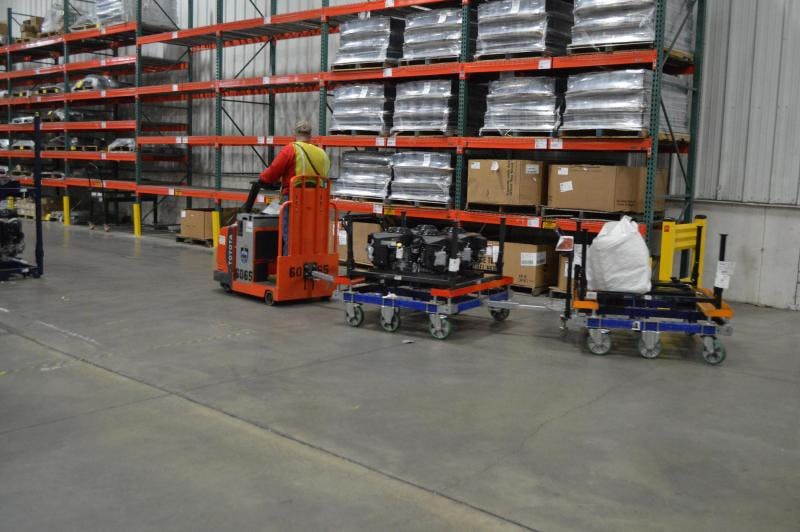5 Forklift Dangers and How to Prevent Them

Modified: 05.03.2020
Forklifts are heavy vehicles used in manufacturing facilities, construction sites, and warehouses.
Forklifts can be useful, but technological advances are beginning to show how inefficient and how dangerous using a forklift can be. Forklifts, also known as fork trucks, can cause harm to the driver and surrounding operators if not appropriately handled. The forklift dangers are many and cause over 20 000 accidents every year. Below are the possible dangers that forklifts can cause and tips on how to avoid them:
1. Falling From Elevated Forks
Factory workers often use forklifts in unloading items to a stacking dock or an internal warehouse. If your employees cannot unload the items, they need to get the items from the actual forklifts. Your operators must then unload the items with extra care. If not, the weight of the loaded items may become unbalanced, and your operators can fall from the elevated forks on the forklift.
The problem occurs when somebody steps on the forklifts to unload the items. To prevent this, your employees should park the forklifts in a safe area, then the assemblers who unload the products should avoid stepping on the forklifts themselves.
2. Bumping into Forklifts
Forklifts are fast-moving vehicles. Battery-powered forklifts are noiseless because they have a different kind of engine, and this makes it very difficult for operators to hear when a forklift is approaching. On top of this, the driver’s inability to see properly makes operating a forklift hazardous for other people on the site. To prevent accidents, ensure your other employees are alert and keep their distance from forklifts.
Tell your managers (if not already done) to add floor marking tape that will keep the forklifts away from operators. Forklift drivers must use these markings as their guide when operating these vehicles. This strategy can help in ensuring a smooth, hassle-free, and safe operation within your facility. It will also decrease the forklift danger within the factory.
3. Overturned Forklifts
It is the number one cause of death and injury associated with forklifts. Many forklift drivers are aware of this, but they often get surprised by how quickly it can take place.
Your workers can deal with this issue in two ways: prevention and how they should respond when faced with this problem.
Train your drivers and teach them the right way to load forklifts. This is the best tactic to prevent these vehicles from overturning. Likewise, make sure they know the most significant weight capacities of the forklifts they operate. Encourage them always to follow the rules. This means implementing speed guidelines and ensure that all fork truck drivers follow these speeds. Inform them that they should avoid driving forklifts on rough terrain — this can be more dangerous, especially for overloaded vehicles.
4. Not Wearing Safety Gear
Wearing seatbelts is vital in operating industrial vehicles like forklifts. If drivers don’t use their seatbelts, the movements of forklifts may push them out of their seats. Wearing belts will help them control these vehicles. Remind your drivers even when the forklifts are not running at high speeds or also if they’re just covering short distances.
5. Unlicensed Forklift Drivers
Forklifts are not challenging to operate. However, it doesn’t mean you can just hire men with experience in driving forklifts. This is not only dangerous. It is a huge violation of several regulations implemented by Occupational Health & Safety. So ensure when hiring forklift drivers within your facility that these drivers are all licensed and have the proper training needed for your forklifts.
Using a Tugger Train System
One of the easiest and safest way to reduce the number of fork truck accidents is by not using fork trucks for material transportation. Many facilities have begun the adaptation towards a tugger train system. This type of system makes it much more efficient and safer to move materials within your warehouse. Instead of using a forklift, the materials are placed on heavy-duty pallet carts. These pallet carts can then be loaded into frames that are connected in a train system or connected via a tow bar. This method of material transportation saves many return trips via forklift and, therefore, can significantly boost productivity within the facility.

Aside from teaching them safety precautions when operating forklifts or working in the presence of forklifts, provide your employees with safety gear and tools. These things will ensure the safety of your workers and everything else in your facility.
Using tugger trains or alternative techniques can create a more efficient material process and is essential when adopting lean manufacturing. Here at FlexQube, we have lots of experience of helping customers implement lean manufacturing methods into their facilities and moving away from forklift environments. Are you wondering how to start the transition from forklifts to a safer working environment, without forklift dangers? In this blog post, you can read more about how to start the transformation.
If you are looking at transitioning away from forklifts and adopting a more lean manufacturing system, feel free to reach out to a FlexQube sales representative to learn more at sales@flexqube.com.




